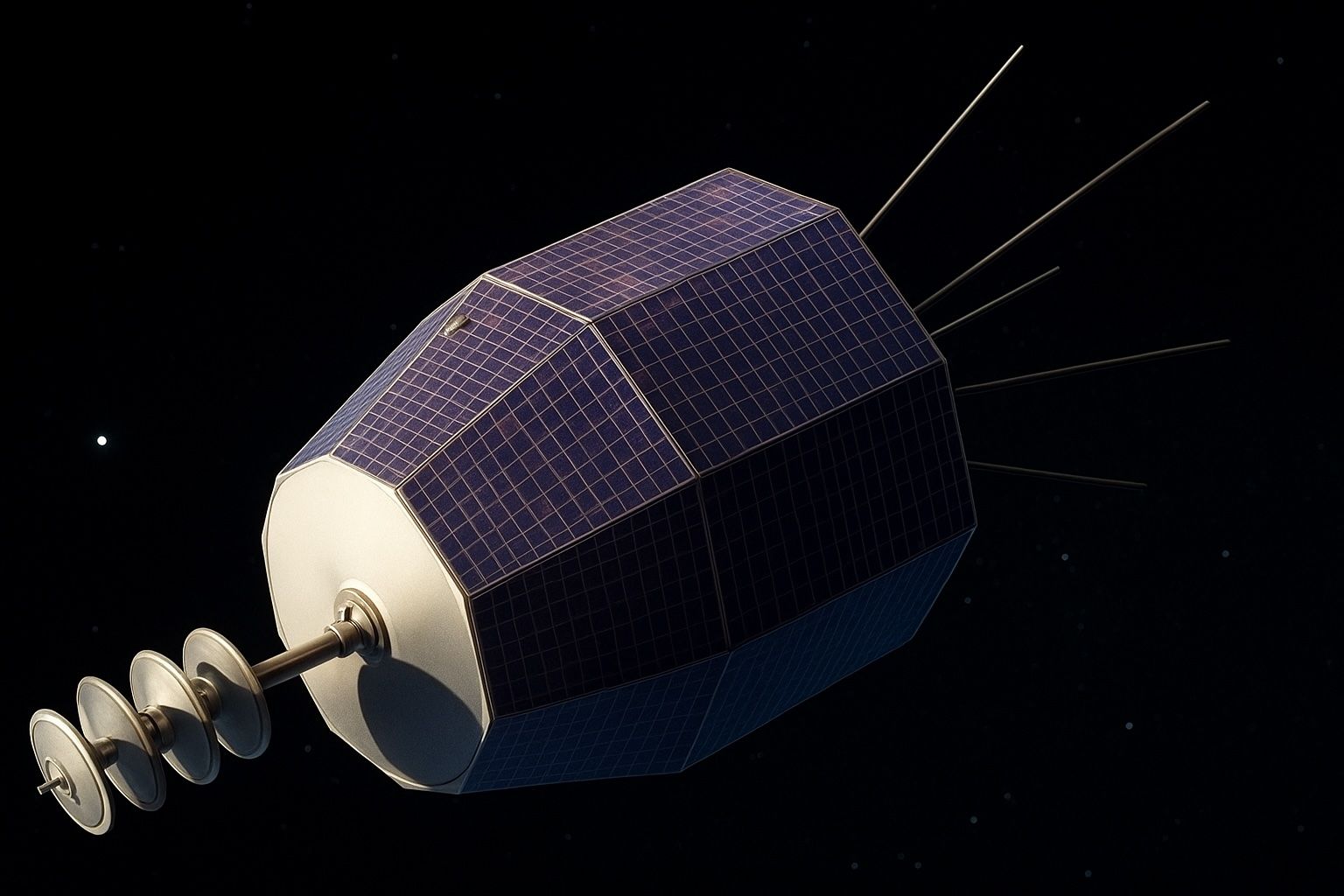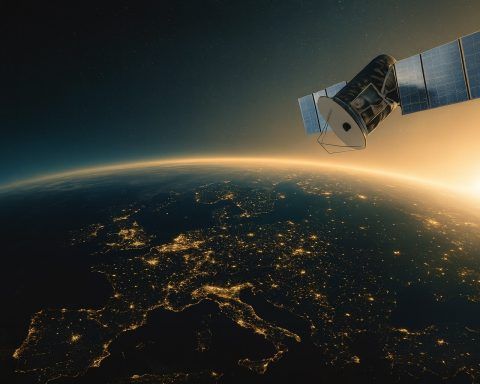- Relay 2 was a NASA experimental communications satellite built by RCA, launched January 21, 1964, atop a Delta B rocket from Cape Canaveral, designed to relay television signals and study Earth’s radiation belts.
- Ground support for Relay 2 ended by September 1965, and its transmitters began failing, with the first transponder dying on November 20, 1966.
- The second transponder failed on June 9, 1967, leaving Relay 2 officially defunct and transmitting for less than three years.
- Relay 2 weighed about 78 kg (172 lb) at launch and orbited in an elliptical medium Earth orbit roughly 1,870 km by 7,600 km.
- From 1968 to 2023 Relay 2 remained silent as a derelict object in orbit.
- On June 13, 2024 the Australian Square Kilometre Array Pathfinder (ASKAP) detected a ~30-nanosecond radio burst from Relay 2’s vicinity, peaking at over 300,000 Jy.
- The burst was detected across roughly 700–1000 MHz in the UHF band and showed virtually no dispersion, indicating a near-Earth, Earth-orbiting source rather than a distant astronomical event.
- Time-of-arrival differences across ASKAP’s antennas allowed near-field localization to about 20,000 km from Earth, matching Relay 2’s predicted orbit.
- Leading hypotheses for the burst are electrostatic discharge on Relay 2 or a micrometeoroid impact creating a hot plasma, both non-astronomical and indicating in-situ energy release.
- The event demonstrated ASKAP’s sensitivity and suggested new methods for remote sensing of derelict satellites, with implications for space debris monitoring and filtering anthropogenic signals in astronomy.
Background: A Long-Defunct NASA Satellite (Relay 2)
Relay 2 is an experimental communications satellite NASA launched on January 21, 1964, as part of the early Relay programen.wikipedia.org. Similar in design to its predecessor Relay 1, this satellite was built by RCA and tasked with relaying television signals and studying Earth’s radiation beltsen.wikipedia.or [1]. After a successful launch atop a Delta B rocket from Cape Canaveral, Relay 2 operated for only a few years. By late 1965, NASA had already stopped routine use of Relay 2 (its dedicated ground station was repurposed) [2] [3]. The satellite’s onboard transmitters then began failing: the first transponder died on November 20, 1966, and the second went silent on June 9, 1967, at which point Relay 2 was considered officially defunct [4] [5]. In total, Relay 2 transmitted data for less than three years before falling mute, effectively becoming a “dead” satellite in orbit.
After 1967, Relay 2 spent decades as an inert piece of space hardware orbiting Earth. It circles in an elliptical medium Earth orbit roughly 1,870 km by 7,600 km in altitude [6] [7]. This long-abandoned satellite, weighing about 78 kg (172 lb) at launch, joined the growing population of orbital debris – part of the 3,000+ defunct satellites estimated to be adrift around Earth today [8] [9]. With no power or communications for nearly six decades, Relay 2 was presumed permanently silent and posed no function beyond being space junk. That is, until an extraordinary event in 2024 proved that even a “dead” satellite can still surprise us.
The Sudden Radio Burst from Relay 2 (2024 Event)
On June 13, 2024, astronomers in Western Australia detected an astonishing burst of radio energy – one that appeared to come out of nowhere. The detection was made by the Australian Square Kilometre Array Pathfinder (ASKAP), a network of 36 radio telescope dishes scanning the skies for transient signals. The signal was blindingly brief, lasting less than 30 nanoseconds (billionths of a second) [10] [11]. In that split-second, however, the radio flash was intense – it peaked at over 300,000 Jansky (300 kJy), meaning it briefly outshone every other radio source in the sky [12] [13]. Such a strong, short burst was wholly unexpected. “We all got excited, thinking maybe we’d discovered a new pulsar or some other object,” recalled Clancy James of Curtin University, who was leading the observation campaign [14]. Initially, the team suspected they might have stumbled upon an exotic cosmic event, like a previously unknown fast radio burst (FRB) or pulsar signal.
However, clues from the data soon revealed a different origin. Unlike distant cosmic bursts, this signal showed virtually no dispersion across its detected frequencies [15] [16]. In other words, the radio waves hadn’t been spread out by traveling billions of light-years through intergalactic plasma (which is what happens with FRBs). Instead, the burst’s characteristics were consistent with having traversed only the Earth’s ionosphere (about 1 ionospheric path worth of dispersion) [17] [18]. Moreover, by analyzing the time-of-arrival delays across ASKAP’s array, the team could triangulate that the source was very nearby in astronomical terms – on the order of 20,000 km from Earth, squarely within the domain of Earth’s orbiting satellites [19] [20]. Cross-checking known orbital tracks, the investigators were stunned to pinpoint a match: the burst appeared to emanate from the location of NASA’s long-dead Relay 2 satellite [21] [22].
Signal Characteristics and Detection
Antennas of the ASKAP radio telescope array in Western Australia, which detected the Relay 2 signal (Credit: CSIRO/ScienceImage).
The mysterious radio pulse from Relay 2 stood out for its ultrashort duration and broad frequency range. The emission was detected across a band of roughly 700–1000 MHz in the UHF spectrum [23] [24]. After sophisticated processing (coherent dedispersion to correct for any ionospheric delay), the team confirmed the burst’s temporal width was under 30 ns [25]. To put that in perspective, 30 nanoseconds is the time it takes light to travel just 9 meters – an extraordinarily brief flash. In that instant, the signal’s flux density was at least 300 kJy (possibly up to ~350 kJy) [26] [27]. This is an enormous intensity – on the order of 100 billion times stronger than the typical signal from a GPS satellite, for example. The burst was so bright that, momentarily, Relay 2 outshone the entire radio sky at those frequencies [28] [29].
Such a high-intensity, nanosecond-duration pulse is unlike most known natural radio sources. Typical pulsars (rotating neutron stars) have pulses lasting milliseconds, and even the fastest cosmic transients (like FRBs) are at least microseconds to milliseconds long and show frequency dispersion from traveling across the cosmos. The Relay 2 signal’s combination of negligible dispersion and extreme brightness immediately flagged it as a likely man-made (near-Earth) event, not an astrophysical explosion [30] [31]. By measuring slight differences in arrival time across the ASKAP antennas (a technique usually used to locate fast radio bursts), researchers could perform a near-field localization – effectively “triangulating” the source in Earth’s vicinity [32]. This pointed to an object a few Earth radii away rather than light-years. The orbital position matched that of Relay 2’s predicted orbit on that date, confirming the defunct satellite as the culprit [33] [34].
As soon as this was realized, the earlier excitement over a potential new pulsar shifted to amazement of a different kind. A nearly 60-year-old satellite that had been dormant since the 1960s had suddenly “blared” a radio signal back at Earth [35] [36]. After that single blip, the object went quiet again – no further pulses were detected in subsequent observations, making the event a one-off (so far). In the words of the New Scientist report, it was like a “dead NASA satellite unexpectedly yelped” and then fell silent [37] [38]. The detection was not only a scientific curiosity but also a demonstration of ASKAP’s impressive sensitivity and new methods to catch ultra-fast transients. The fact that ASKAP caught this during a scheduled survey indicates that such brief events can be captured with modern instruments – opening the door to finding similar occurrences in the future.
Possible Causes: Electrostatic Discharge vs. Micrometeoroid Impact
What could make a “dead” satellite with no power suddenly emit a powerful radio pulse? Given that Relay 2’s transmitters have been cold and unpowered for decades, the burst was certainly not a deliberate radio transmission. Instead, scientists have narrowed it down to two plausible physical causes, both involving sudden releases of energy from the satellite’s hardware rather than any intentional signal. The leading hypotheses are: (1) an electrostatic discharge (ESD) on the satellite’s surface, or (2) a high-velocity impact by a micrometeoroid, creating a burst of plasma.
Electrostatic discharge occurs when charge builds up on a spacecraft and suddenly discharges – analogous to a tiny lightning strike or static-electric spark. Satellites in orbit can accumulate charge from the space environment (solar UV radiation, plasma in Earth’s magnetosphere, etc.). If enough charge accumulates on different parts of an insulating surface, a sudden discharge (arc) can occur. Such ESD events can emit broadband radio noise. In fact, similar discharge phenomena were observed previously by the Arecibo radio telescope, although those were on much longer microsecond timescales [39] [40]. Clancy James and colleagues suggest that Relay 2 may have experienced a surface charge buildup and a sudden spark (arc), which in turn emitted the nanosecond radio burst [41] [42]. Because ASKAP caught the event in progress, this would be the first remote detection of an ESD on an orbiting satellite – a remarkable feat. If this scenario is correct, it highlights a real hazard: ESD can damage satellite electronics, and being able to detect these discharges remotely might help engineers design better protections [43].
The other main possibility is a micrometeoroid impact on Relay 2. Space is filled with tiny dust grains (micrometeoroids) and also bits of orbital debris. A particle only millimeters across, moving at tens of kilometers per second, carries enough kinetic energy to vaporize material on a spacecraft upon impact. If a micrometeoroid hit Relay 2, it could have instantaneously vaporized a bit of metal or dielectric material, creating a hot plasma cloud near the satellite’s surface [44] [45]. A rapidly expanding plasma can emit a brief radio burst, much like a mini-explosion emitting electromagnetic radiation. The team notes that a known example of this was a micrometeoroid strike that damaged a Soyuz spacecraft in 2018 – that impact likely generated an electromagnetic pulse as well [46]. For Relay 2, a similar hypervelocity impact could explain a sudden, broadband nanosecond flash of radio energy. Unlike an ESD, which is an “internal” discharge, an impact involves an external agent (a tiny rock or debris fragment) essentially “sparking” the satellite by collision.
Distinguishing between these two scenarios – ESD vs. impact – is challenging with just a single observed burst and no onboard sensors. Both would produce a quick, intense radio spike. Dr. Karen Aplin of the University of Bristol, an expert in space environment and instrumentation, noted that determining the exact cause might not be possible from ground detection alone [47] [48]. “Distinguishing between these scenarios is challenging,” she said, “However, this kind of radio-based detection may prove valuable as space becomes increasingly crowded with debris and small satellites susceptible to such electrical or collision events.” [49] In either case, the event provides a proof-of-concept that even passive, unpowered satellites can produce detectable signals under rare circumstances. The Astrophysical Journal study reporting the find explicitly highlights that Relay 2’s pulse represents a new category of “false alarms” for transient astronomy – transient radio flashes that are neither astrophysical nor intentional human broadcasts [50]. It’s a reminder that our instruments are now sensitive enough to catch even the “ghosts” of old satellites.
Notably, NASA and other agencies have not suggested any more exotic explanation for the Relay 2 burst – there is no evidence to support ideas like an alien interaction or a secret transmitter. Experts underscore that the simplest explanations (a static discharge or impact) suffice to explain the data [51] [52]. In short, physics – not “phasma” – brought this zombie satellite momentarily back to life.
Expert Commentary and Scientific Significance
The unexpected Relay 2 signal has generated considerable buzz in both the space engineering and astronomy communities. Scientists are intrigued not only by the novelty of the event but also by its implications. Clancy James, the lead researcher from Curtin University, emphasized how initially misleading the burst was: with such brightness, “we all got excited” thinking it was a new cosmic phenomenon [53]. This speaks to the need for vigilance – even seasoned astronomers momentarily considered an extraterrestrial source until the data pointed closer to home. Once the source was pinned to Earth orbit, the discussion shifted to what this means for current and future observations.
Radio astronomers note that Relay 2’s burst is a wake-up call about anthropogenic (human-made) radio transients. Telescopes like ASKAP, CHIME, and in the future the Square Kilometre Array (SKA) are hunting for fast radio bursts and other brief cosmic signals. Now they must also account for the possibility of satellite-generated bursts that can mimic far-away phenomena [54]. Fortunately, the Relay 2 signal had tell-tale signatures (lack of interstellar dispersion, near-field localization) that allowed it to be identified correctly [55] [56]. Moving forward, surveys may incorporate automated checks against known satellite positions to filter out such events. As Dr. Aplin pointed out, this event “may prove valuable” by demonstrating a method to differentiate Earth-orbit events from genuine cosmic ones using dispersion and timing [57] [58]. In other words, it adds a new layer to our understanding of “radio frequency interference” – not just constant chatter from satellites, but even one-time bursts from derelict objects.
Space engineers and mission designers are also interested. If the burst was due to an electrostatic discharge, it provides real data on ESD events in orbit. ESDs are a known threat: a sudden discharge can damage electronics, and they are suspected in many satellite anomalies. Yet they are hard to study because they happen randomly and rapidly in space. Now, having possibly caught one in the act opens the door to using large radio telescopes as remote sensing tools for satellite health. One could imagine deliberately monitoring retired satellites or high-risk spacecraft for ESD signatures – a bit like listening for “screams” from stressed hardware – to gauge the space environment’s effects in real time [59]. Similarly, if the cause was a micrometeoroid impact, it underscores how even small particles can produce detectable electromagnetic signatures. This might complement existing impact detection methods (like satellite accelerometers or visual inspection) by providing a remote RF sensing technique. For instance, if a critical satellite experienced a meteoroid hit, an array like ASKAP or the upcoming SKA might catch the telltale burst, alerting operators to check the satellite for damage.
From a space situational awareness perspective, Relay 2’s pulse highlights the broader issue of orbital debris and defunct objects. There are thousands of “dead” satellites and countless fragments orbiting Earth. As space becomes more crowded, the chance of collisions or random events like this will only increase [60] [61]. Some commentators have dubbed these derelict craft “zombie satellites” – not alive, but occasionally reanimated in some sense [62] [63]. While Relay 2’s radio flash did no harm, it serves as a dramatic illustration that space junk is not entirely inert. Pieces of debris can collide and produce energetic events; old satellites can shed charged particles or even explode (as has happened when leftover fuel or batteries ruptured). All these events can interfere with operational systems or scientific observations. Thus, this incident adds weight to calls for better tracking and perhaps active remediation of orbital debris. Even the task of simply cataloguing such events becomes important – scientists might start asking, “Have any other retired satellites emitted anomalous signals that we missed?” It’s possible that without the keen ears of ASKAP, a nanosecond burst like this could have gone completely undetected or dismissed as instrumental noise.
“Zombie” Satellites: Past Incidents and Comparisons
Relay 2’s surprise signal brings to mind other so-called “zombie satellites” – spacecraft that, after long dormancy, have unexpectedly shown signs of life. There have been a few notable cases in past decades, each with different causes, that space enthusiasts often recall:
- LES-1 (Lincoln Experimental Satellite 1) – A U.S. Air Force satellite launched in 1965 and abandoned in 1967. In 2012, amateur radio operators were astonished to pick up a radio signal from LES-1 after 45 years of silence [64]. In that case, the satellite’s electronics intermittently resumed transmitting when its solar panels happened to align with the Sun. Essentially, a failed component caused LES-1’s power system to cycle with sunlight, creating a periodic pulse signal decades after the mission end. It was a true electronic zombie, “coming alive” when conditions were just right, then dying each orbit when in darkness.
- AMSAT-OSCAR 7 – An amateur radio satellite launched in 1974. It failed in 1981 due to battery issues, and was thought lost. Amazingly, in 2002 (21 years later), ham radio operators heard OSCAR-7 transmitting again [65]. The theory is that its failed battery eventually opened (like an internal short going open circuit), allowing the satellite to run directly off its solar panels whenever in sunlight. Thus, after two decades of quiet, OSCAR-7 rose from the grave and remains intermittently operational to this day when illuminated.
- Galaxy 15 – A commercial communications satellite launched in 2005 by Intelsat. In April 2010, Galaxy 15 malfunctioned and stopped responding to ground commands, drifting out of its slot. However, its transponders remained on, relaying signals autonomously – earning it the nickname “ZombieSat” in news reports. In December 2010, after months of aimless wandering, Galaxy 15 unexpectedly rebooted itself and started responding again, allowing Intelsat to regain control [66]. This was a case of onboard software eventually resetting after an upset. Operators successfully “resurrected” the satellite and returned it to service, an almost literal comeback from the dead.
- IKAROS (and others) – On occasion, even relatively recent spacecraft surprise us. Japan’s IKAROS solar sail probe, for example, went quiet in 2012 but was heard again in 2015. And there are a few instances of old probes or orbiters that were later re-detected by NASA or hobbyists (e.g., NASA’s ICE/ISEE-3 was contacted in 2014 after 17 years inactive). These are slightly different since they involved intentional re-contact by humans, not spontaneous signals, but they contribute to the “zombie satellite” lore.
In all the examples above, a common thread is that some latent capability in the satellite was revived – a powered transmitter came back on, either by design or accident. Relay 2’s case is unique in that its burst was extremely brief and likely caused by a physical event rather than any revival of its systems. Relay 2 didn’t resume normal operations or start continuously broadcasting; it simply emitted a single pulse and then went silent again [67] [68]. “It’s more of a ghostly hiccup than a resurrection,” one might say. This underscores that there are multiple failure modes and post-mission behaviors for satellites: some may reboot or be rebooted, while others, like Relay 2, might just flare once due to environmental interactions. All fall under the colorful umbrella of “zombie satellites,” reminding us that even in space, dead doesn’t always mean completely dead [69].
The Relay 2 event also differed in its potential for confusion with natural phenomena. The above examples (LES-1, OSCAR-7, etc.) were relatively slow signals that were quickly identified as man-made. Relay 2’s nanosecond burst, on the other hand, could have been mistaken for something like an FRB if not properly analyzed [70] [71]. It enriches the catalog of weird things satellites can do – from slow telemetry drifts to fast transient blasts. As more satellites reach end-of-life in the coming years (especially with mega-constellations growing), we may yet see other strange “zombie” behaviors, though the Relay 2 burst currently stands as one of the most striking on record.
Future Investigations and Broader Implications
Simulation of orbital debris around Earth (white dots) in low Earth orbit – an growing congestion of defunct objects (Credit: NASA ODPO).
The unexpected blast from Relay 2 has prompted both scientific curiosity and practical considerations. Going forward, researchers plan to keep an ear out for similar events. The team that spotted this pulse has already published their findings and noted that they have opened a new avenue for “remote sensing” of such incidents [72]. In practical terms, this means radio astronomers might start looking not just for cosmic signals, but also systematically checking data for any unaccounted bursts that could come from Earth-orbiting objects. With facilities like the Square Kilometre Array (SKA) coming online in the near future – which will be even more sensitive than ASKAP – the chances of detecting another nanosecond-scale event will increase. Current plans include incorporating algorithms to distinguish near-field (satellite-origin) transients from far-field ones, using methods like multiple-antenna timing and known satellite ephemerides. The goal is twofold: avoid false alarms in astrophysical surveys, and capture more examples of these events to build up statistics [73] [74]. If Relay 2 was one in a million, perhaps only SKA-level sensitivity would regularly catch such occurrences, but now astronomers know to be on the lookout.
Space agencies like NASA and ESA, which track orbital debris, are also interested. While one radio flash from a 60-year-old satellite is not an immediate game-changer, it does offer a proof of concept for monitoring derelict objects. NASA’s Orbital Debris Program Office already uses radar and telescopes to track objects and even characterize some breakup events. They could now consider whether large radio arrays might contribute to debris monitoring – for instance, detecting a breakup via radio bursts if two pieces collide and produce a plasma flash. It’s a novel idea that needs exploration. At the very least, mission teams of active spacecraft may take note. If a satellite experiences an unexplained anomaly, engineers might ask: “Did anyone see a burst of RF at that time?” – a question that previously wasn’t on the checklist. The Relay 2 burst shows that, under the right conditions, even a retiring satellite can effectively “send a distress call” of sorts (albeit an unintentional one).
The event also feeds into the larger narrative of ensuring satellite reliability and safe end-of-life. Modern satellite design may incorporate features to mitigate charge build-up (preventing ESD) and shielding against micrometeoroids. Knowing that such incidents are detectable might encourage more studies of material charging in space. It could even lead to policy discussions: for example, if old satellites pose a risk of radio interference decades later, should we deorbit them sooner? This is somewhat analogous to how derelict satellites can pose collision risks; now we see they might pose signal risks too (albeit rare). The broader implication is that space environment management remains an important issue – whether it’s preventing physical collisions or minimizing unexpected electromagnetic noise.
From the perspective of radio astronomy, the Relay 2 surprise underscores the importance of international cooperation between astronomers and satellite operators. Groups like the SETI Institute, which search for technosignatures (signals of alien technology), also took note – because one day a signal that looks artificial might be detected, and we’ll need to discern if it’s ours or theirs. In this case, it was ours (just from half a century ago). Jon Richards, an engineer at SETI (hypothetically speaking), might quip that “it’s never aliens, it’s usually something like a stray satellite”. Indeed, many false alarms in SETI history have turned out to be human-made interference. The lesson from Relay 2 is that not only active satellites but even “dead” ones can produce interference. Thus, SETI and other radio sky surveys will factor this in. It’s a comfort, perhaps, that our instruments are now so sensitive that even an old satellite’s hiccup can be heard – but it means we must remain diligent in filtering our data.
In conclusion, the powerful radio pulse from a defunct NASA satellite has opened a new chapter in both astronomy and space operations. A relic of the Space Age’s early years managed to startle scientists in 2024, reminding us that the space around Earth is far from empty or boring. The event bridged 60 years of history: Relay 2, a project that broadcast President Kennedy’s assassination news in 1963 via its sister satellite [75], suddenly made headlines of its own in 2025 by challenging our assumptions about “dead” spacecraft. As we venture into an era with tens of thousands of satellites (and inevitably, many more defunct ones), such episodes may no longer be viewed as mere oddities, but as phenomena to understand and anticipate. A tiny spark in the darkness above Earth was enough to captivate scientists worldwide, and in doing so, it shed light on issues of space debris, satellite design, and the need for ever-vigilant eyes and ears on the sky [76] [77]. The “zombie” satellite Relay 2 might be quiet again, but it has certainly given us plenty to talk about – and perhaps, it won’t be the last time an artifact of the past reaches out with an unexpected signal.
Timeline of Key Events and Discoveries
- January 21, 1964 – Launch of Relay 2: NASA launches Relay 2 from Cape Canaveral into medium Earth orbit [78]. It joins Relay 1 as part of an early communications satellite experiment.
- September 1965 – End of official operations: Ground support for Relay 2 ends (the only communication station was reassigned), effectively terminating its mission [79] [80]. The satellite continues transmitting telemetry for a while on its own.
- November 20, 1966 – First transmitter failure: Relay 2’s primary transponder stops working [81]. The satellite’s signal becomes intermittent.
- June 9, 1967 – Satellite falls silent: The second (backup) transponder fails, and Relay 2 ceases all communications [82]. It is now a derelict object in orbit.
- 1968–2023 – Silent decades in orbit: Relay 2 remains in orbit, gradually moving in its elliptical path. As of the 2020s it is one of thousands of defunct satellites orbiting Earth [83]. No signals are heard from it during this period.
- June 13, 2024 – Relay 2 emits a radio burst: ASKAP in Australia detects a ~30 ns radio flash from Relay 2’s vicinity [84] [85]. The burst briefly outshines all other radio sources and is later localized to the satellite.
- Late 2024 – Analysis and paper preparation: Clancy James and team analyze the event, determine likely causes (ESD or micrometeoroid) and write a paper documenting the discovery [86].
- June 2025 – Public disclosure: The research is published (accepted in Astrophysical Journal Letters, preprint on arXiv) and reported in the press [87] [88]. New Scientist breaks the story on June 20, 2025 [89], followed by coverage in other outlets worldwide.
- Future – Ongoing monitoring: Radio observatories plan to monitor for similar events. The incident drives new discussions on satellite end-of-life behavior, space debris risks, and improvements in filtering human-made signals in astronomy datasets [90] [91]. Scientists consider the Relay 2 event a benchmark for any future “rogue” signal from defunct objects, ensuring that the next time a dead satellite screams, we’ll be ready to understand it.
References
1. en.wikipedia.org, 2. ts2.tech, 3. ts2.tech, 4. www.foxweather.com, 5. ts2.tech, 6. en.wikipedia.org, 7. ts2.tech, 8. www.foxweather.com, 9. ts2.tech, 10. www.chron.com, 11. www.iflscience.com, 12. www.chron.com, 13. ts2.tech, 14. www.chron.com, 15. arxiv.org, 16. ts2.tech, 17. arxiv.org, 18. arxiv.org, 19. www.chron.com, 20. ts2.tech, 21. www.chron.com, 22. ts2.tech, 23. arxiv.org, 24. ts2.tech, 25. arxiv.org, 26. www.chron.com, 27. ts2.tech, 28. www.chron.com, 29. ts2.tech, 30. ts2.tech, 31. ts2.tech, 32. ts2.tech, 33. www.chron.com, 34. ts2.tech, 35. ts2.tech, 36. ts2.tech, 37. en.wikipedia.org, 38. ts2.tech, 39. www.iflscience.com, 40. arxiv.org, 41. www.iflscience.com, 42. arxiv.org, 43. arxiv.org, 44. www.chron.com, 45. www.iflscience.com, 46. www.iflscience.com, 47. www.chron.com, 48. ts2.tech, 49. www.chron.com, 50. arxiv.org, 51. www.chron.com, 52. arxiv.org, 53. www.chron.com, 54. arxiv.org, 55. ts2.tech, 56. ts2.tech, 57. ts2.tech, 58. ts2.tech, 59. arxiv.org, 60. www.chron.com, 61. ts2.tech, 62. www.foxweather.com, 63. www.iflscience.com, 64. www.foxweather.com, 65. www.iflscience.com, 66. www.iflscience.com, 67. ts2.tech, 68. ts2.tech, 69. www.iflscience.com, 70. ts2.tech, 71. ts2.tech, 72. arxiv.org, 73. arxiv.org, 74. ts2.tech, 75. www.iflscience.com, 76. www.chron.com, 77. arxiv.org, 78. ts2.tech, 79. en.wikipedia.org, 80. ts2.tech, 81. www.foxweather.com, 82. www.foxweather.com, 83. ts2.tech, 84. www.chron.com, 85. ts2.tech, 86. arxiv.org, 87. arxiv.org, 88. en.wikipedia.org, 89. en.wikipedia.org, 90. ts2.tech, 91. ts2.tech





